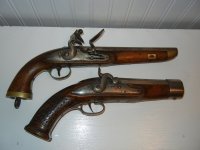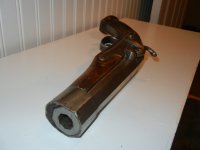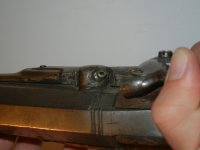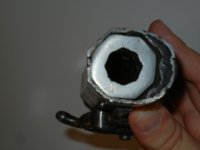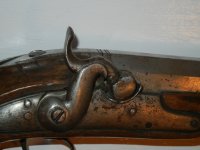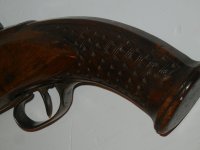I have acquired two muzzleloading pistols that had previously been in my family's possession for as long as I can remember. I'm hoping someone here can help identify one of them for me.
They were given to us by a distant relative of mine, who has long since passed away. He was a German immigrant who apparently brought them over with him. Aside from that, I know nothing about how he came to possess them.
The first one is a smoothbore flintlock pistol of .70 caliber. It has a lanyard ring but no provision for a ramrod. Its best days are long behind it, but the lockwork is in perfect mechanical condition. After an hour or two of research, I've identified it as a Belgian pistol that was produced during the late 18th and early 19th centuries for export. A quick Google search for "Belgian flintlock pistol" yields identical pistols of similar description.
I have absolutely no idea what the second one is, aside from it's a percussion caplock pistol of roughly the same caliber. It also has no provision for a ramrod. The bore is almost too gunked up to tell, but it is rifled.
Unlike the flintlock, there are NO markings anywhere on it.
It has an octagonal barrel, and the grip is elegantly checkered. Otherwise, it's in TERRIBLE shape. The lock doesn't work at all and the nipple is all buggered up, as if someone constantly dry fired it for about a century.
It has a large iron barrel band that abruptly ends at the muzzle. It looks to me as if the caplock mechanism is not original to the pistol.
I have two guesses as to what this might be:
A. This is an individual gunsmith's creation, or
B. This was once a flintlock rifle that Bubba's great-great-grandfather chopped down to a pistol and crudely converted to percussion.
Anyone got any better ideas? Thanks in advance.
They were given to us by a distant relative of mine, who has long since passed away. He was a German immigrant who apparently brought them over with him. Aside from that, I know nothing about how he came to possess them.
The first one is a smoothbore flintlock pistol of .70 caliber. It has a lanyard ring but no provision for a ramrod. Its best days are long behind it, but the lockwork is in perfect mechanical condition. After an hour or two of research, I've identified it as a Belgian pistol that was produced during the late 18th and early 19th centuries for export. A quick Google search for "Belgian flintlock pistol" yields identical pistols of similar description.
I have absolutely no idea what the second one is, aside from it's a percussion caplock pistol of roughly the same caliber. It also has no provision for a ramrod. The bore is almost too gunked up to tell, but it is rifled.
Unlike the flintlock, there are NO markings anywhere on it.
It has an octagonal barrel, and the grip is elegantly checkered. Otherwise, it's in TERRIBLE shape. The lock doesn't work at all and the nipple is all buggered up, as if someone constantly dry fired it for about a century.
It has a large iron barrel band that abruptly ends at the muzzle. It looks to me as if the caplock mechanism is not original to the pistol.
I have two guesses as to what this might be:
A. This is an individual gunsmith's creation, or
B. This was once a flintlock rifle that Bubba's great-great-grandfather chopped down to a pistol and crudely converted to percussion.
Anyone got any better ideas? Thanks in advance.

